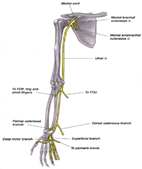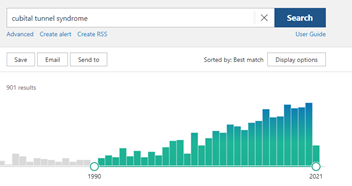What Is the Cubital Tunnel Syndrome?
Cubital tunnel syndrome, a compressive neuropathy of the ulnar nerve at the elbow, is the second most common compressive neuropathy in upper extremities (1st = carpal tunnel syndrome). To understand how peripheral nerves get injured, go here (insert “anatomy of peripheral nerve injury blog).
The Ulnar nerve is a continuation of nerve roots from your middle and lower neck (cervical spine) that get combined in the upper arm and then travel down the inside of your arm. It enters the cubital tunnel on the inside of your elbow and then travels to your hand.

How Successful Is Cubital Tunnel Surgery?
In recent years, physicians have been favoring surgery. In a study by Osei et al., 41.3% of patients diagnosed with cubital tunnel syndrome were eventually treated surgically in their study period of 6 years. BUT does the level of evidence favor the need for such high surgical conversion rates? (Osei)
The amount of cubital tunnel surgery research has increased but very few high level studies even exist to confirm the safety and efficacy of surgery. A 2019 meta-analysis demonstrated “The current body of evidence regarding cubital tunnel syndrome lacks prospective, randomized, controlled trials, uniform reporting of indications, and standardized outcome scoring. (Said)

Revision rates for persistent or recurrent cubital tunnel syndrome are at around 19% (almost 2 out of 10 patients need another surgery!). Common causes for failure include incomplete release of the entrapment and postoperative perineural scarring (avache). The most common finding at revision surgery was perineural scarring (79%), with the most frequent entrapment site being the medial intermuscular septum (33%) (kho). Studies also show that the outcome of revision surgery is less favorable than after primary surgery and complete resolution of symptoms is unlikely.
To get surgery or not? Functional outcomes were averagely reported and varied widely. A consensus regarding the functional outcome parameters after surgery for cubital tunnel syndrome is urgently needed.
The Future Non-Surgical Alternatives
We continue to push the boundaries of interventional procedures utilizing the most advanced regenerative ortho-biologics to allow natural healing of the nerve while hydrodissecting, percutaneously decompressing without the need of surgery! If you’d like to find out if you’re a candidate for our advanced peripheral nerve injury treatment, feel free to contact us today for a full evaluation.
Ayache A, Unglaub F, Tsolakidis S, Schmidhammer R, Löw S, Langer MF, Spies CK. Revisionseingriffe beim Karpal- und Kubitaltunnelsyndrom [Revision surgery for carpal and cubital tunnel syndrome]. Orthopade. 2020 Sep;49(9):751-761. German. doi: 10.1007/s00132-020-03969-7. PMID: 32857166.
Kholinne E, Alsharidah MM, Almutair O, Aljasser S, Alhothali W, Kwak JM, Sun Y, Lee HJ, Koh KH, Jeon IH. Revision surgery for refractory cubital tunnel syndrome: A systematic review. Orthop Traumatol Surg Res. 2019 Sep;105(5):867-876. doi: 10.1016/j.otsr.2019.03.020. Epub 2019 Jul 19. PMID: 31331798.

